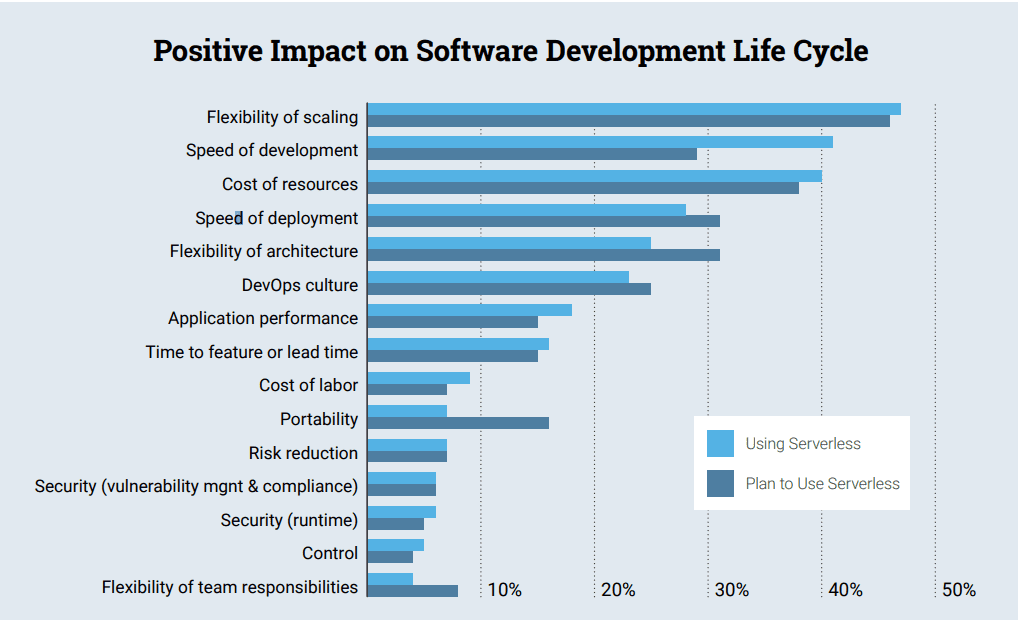Over 75% of organizations are either using or planning to use serverless computing in next 18 months, according to The New Stack Serverless Survey 2018.
An increasing number of developers are preferring serverless computing to avoid the complexities of modern software development. In the development arena today, the developers are concerned about performance, scalability, security, privacy and more burdens. All these aspects can not only overwhelm a beginner, but also a veteran engineer.
That is the reason serverless computing is more than just a technology. It’s also a movement. Serverless architecture is transforming the way software developers build, deploy, and manage applications today. It also positively impacts the business decision-making and structure of the organization.
AWS released the first serverless platform – AWS Lambda in 2014. Other cloud providers like Google and Microsoft also launched their serverless computing services post that.
Serverless offerings like Microsoft Azure functions and AWS Lambda are seeing a strong growth quarter over quarter. No need of managing infrastructure remains the primary reason for this growth.
Another benefit of serverless is that it’s pay-as-you-go, calculated on the basis of consumption rather than pre-purchased services on guesswork. It is also accessible to people, and its infrastructure is completely invisible.
“The point of calling something serverless is to say that we no longer need to run, and manage [virtual or physical] servers ourselves,” writes Peter Sbarski, Serverlessconf organizer. “We do not even have access to them.”
Highlights of The New Stack Serverless Survey 2018:
Serverless: the next evolution of a microservice architecture
As well explained by Erica Windisch, co-founder and CTO of IOpipe, the serverless is next evolution of a microservice architecture. Cloud providers are essentially taking what were best practices with containers and Docker, but enforcing them as part of the serverless model.
They are providing four of the factors of a traditional twelve-factor application built on a microservice architecture, and baking them into a serverless platform. These four factors include processes, concurrency, disposability, and logs as event streams. Developers get these factors as part of the serverless platform.
Half of organizations already using serverless architecture
The New Stack surveyed over six hundred organizations globally in August this year. The survey found that around 50% of organizations are currently using a serverless architecture, and 28% are planning to do so in next 18 months.
Impacts of serverless on software development lifecycle
41% of the organizations that are using serverless computing reported speed of development as one of the top advantages of serverless.
However, only 29% of the organizations that are planning to deploy serverless cited speed of development as a top benefit.
Respondents also indicated flexibility of scaling, cost of resources, speed of deployment, DevOps culture, application performance, etc. as the main benefits of serverless architecture.

Serverless: kind of a time machine for developers
Serverless computing reduces the time from code development to putting that code in production. There is no infrastructural drag in between the coding and running it. It’s like “here is my code, now run it,” or “here is my data, now store it.”
Chad Arimura, vice president of serverless at Oracle explains, “The basic idea is a developer just writes code and pushes to a serverless service. That’s it. The rest is handled by the service. Better yet, dependencies like database and storage are also services folded in seamlessly under the serverless hood.”
“Behind the scenes, specialized teams combined with a lot of automation are operating these systems at scale, so that the developer doesn’t have to think about this stuff. It does kind of look and feel like magic and moonbeams, which is why the hype cycle is strong with serverless. Because it’s such a better experience.”
Top 10 technologies on serverless roadmap for 2019 and beyond
Nowadays, function as a service (FaaS) is grabbing the most attention, as it is the most transformative factor of serverless. It changes the way developers build applications.
Of the FaaS products in use, AWS Lambda is the number one product on serverless roadmaps. As per the report, 71% of organizations said that they were either using or planning to use Lambda in next 18 months.
Suggested reading: Serverless computing comparison guide: AWS, Google, IBM and Microsoft
There are the best technologies on serverless roadmap for next 18 months:
- AWS Lambda
- Amazon CloudWatch
- Azure Functions
- Serverless Framework
- AWS Server Application Model
- Google Cloud Functions
- Kubeless
- Python Lambda
- OpenFaaS
- Apache OpenWhishk

Top technical use cases of serverless
Majority of organizations consider HTTP REST API, batch jobs, and business logic as the best technical use cases of serverless.
- HTTP REST APIs and web applications
- Batch jobs or scheduled tasks
- Business logic
- Continuous integration pipeline
- Stream processing at scale
- Database changes or change data capture (CDC)
- Mobile backends
- Chat bots
- IoT sensor input messages
- Multimedia processing
Also read: Top 4 development trends in cloud of which every developer should be aware of
Downsides of serverless
For all the advantages of serverless, there are some limitations as well. The respondents cited portability, control, application performance, and risk reduction as the most common downsides of serverless in their organizations.

To download The New Stack Serverless Survey 2018 report, click here.








